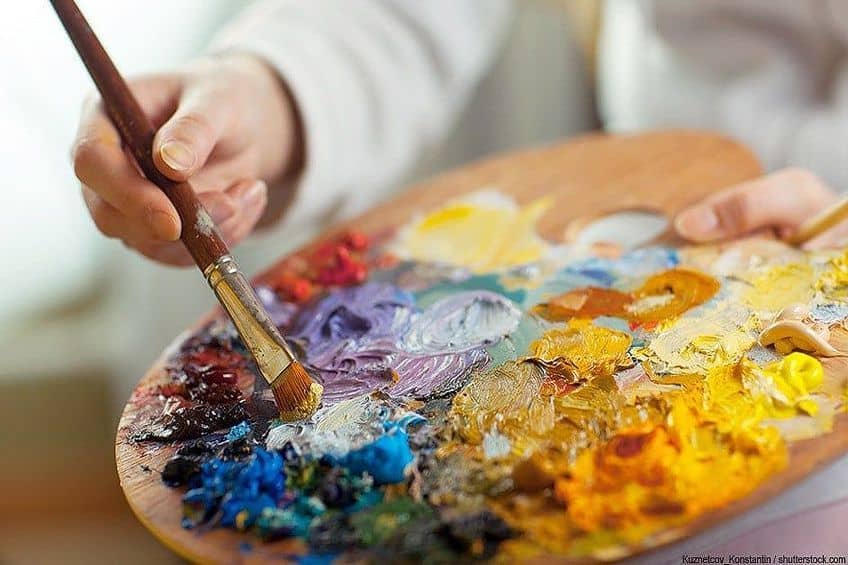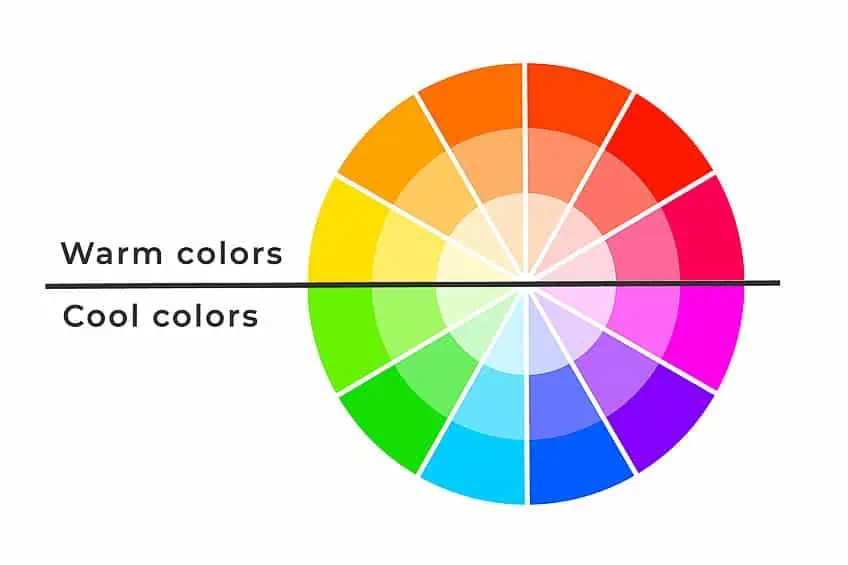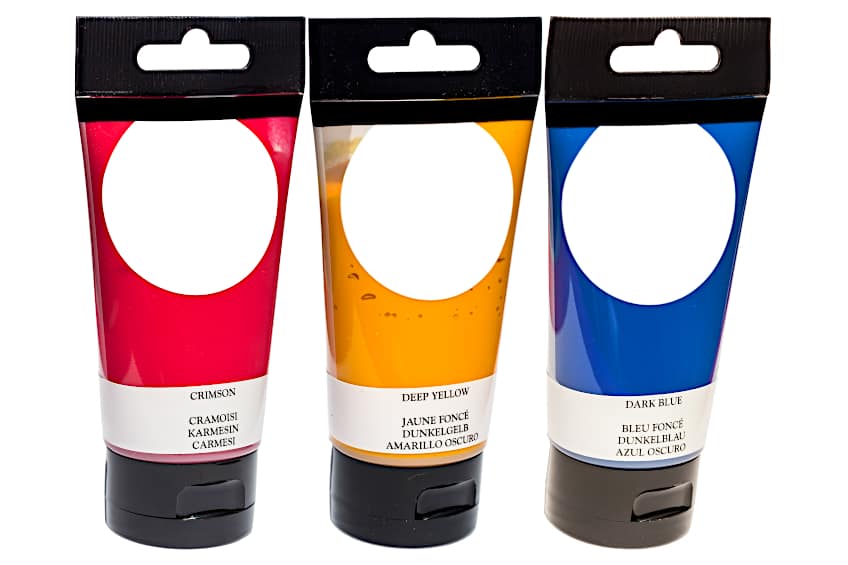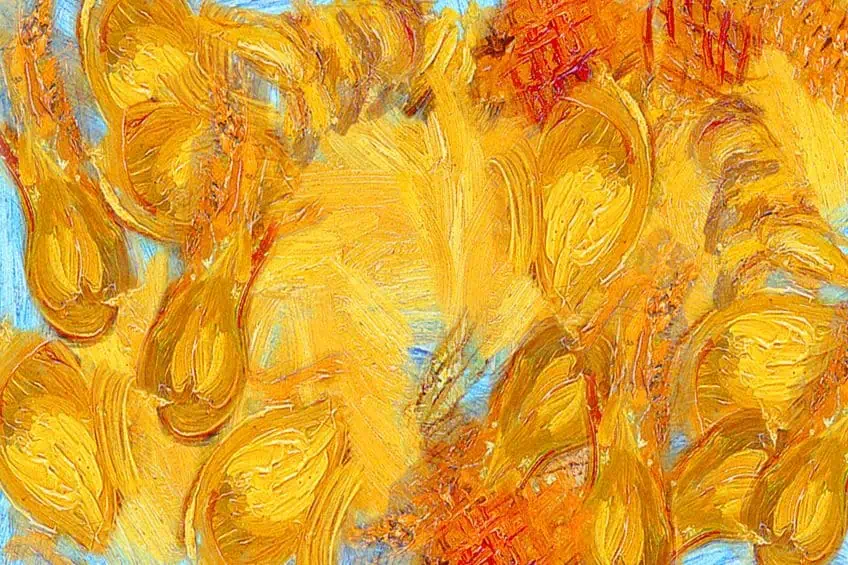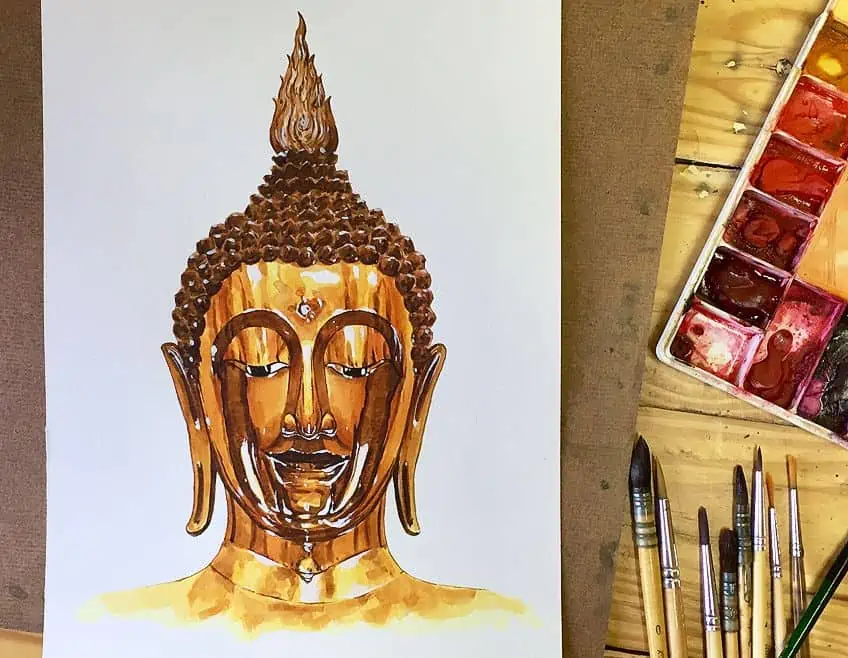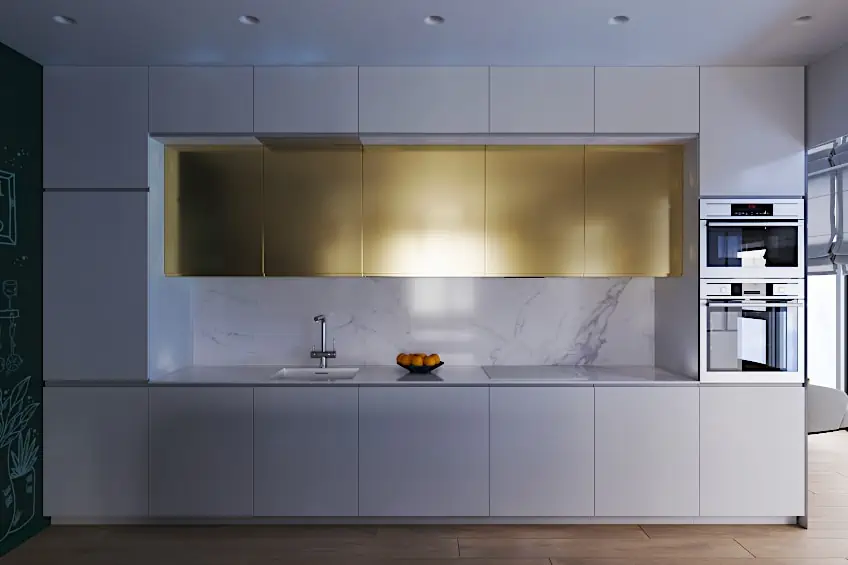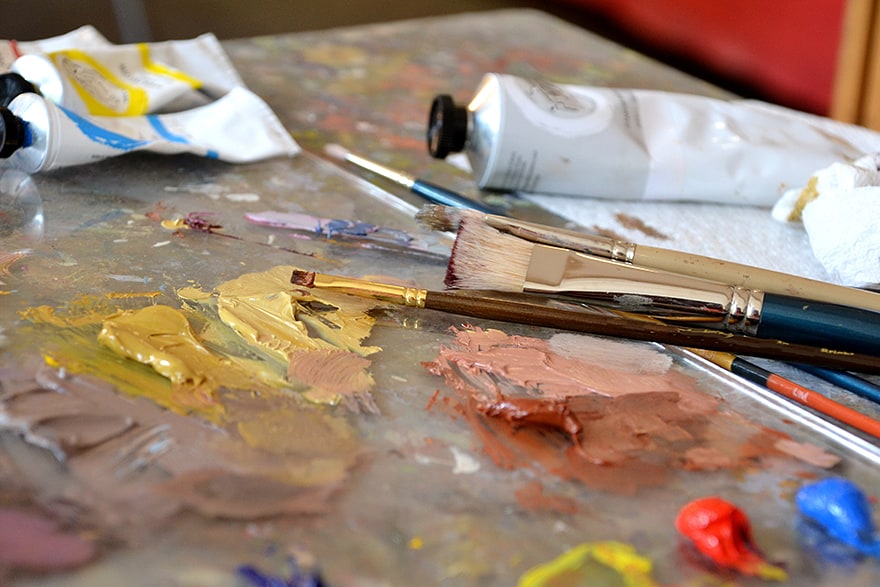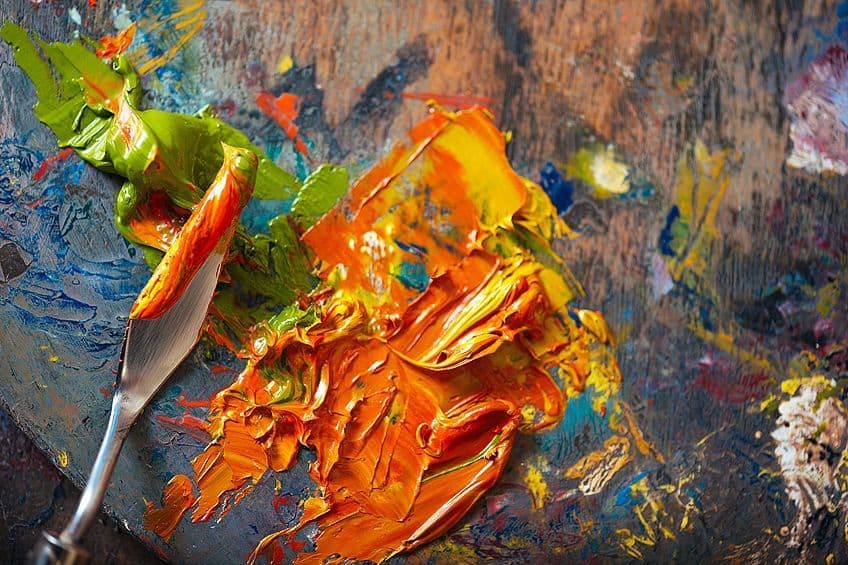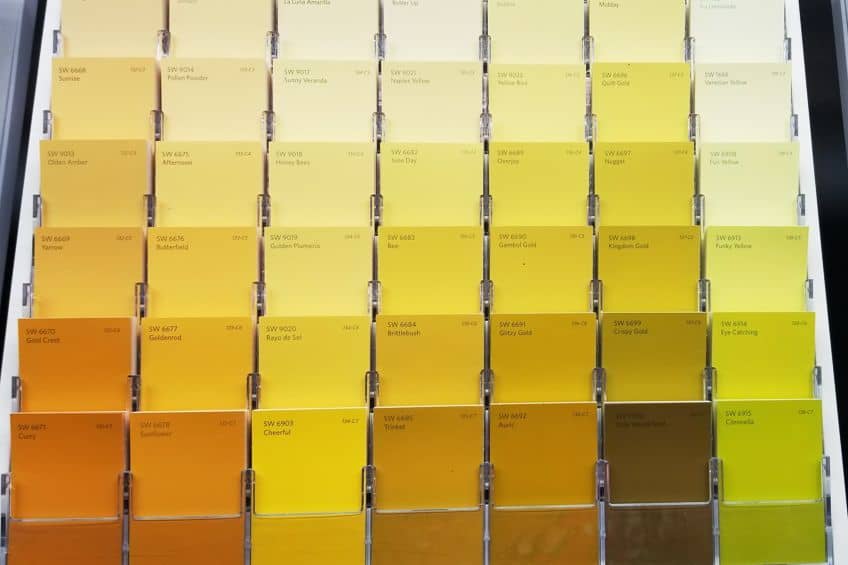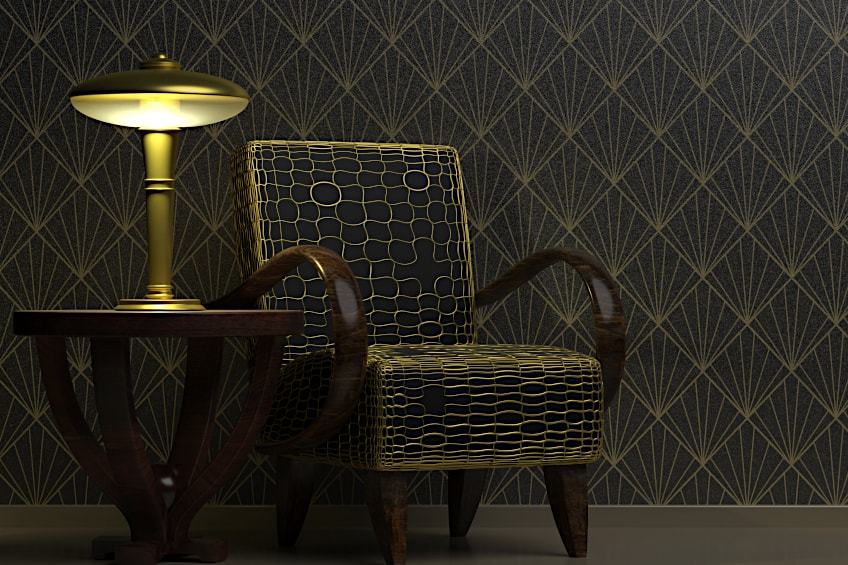What Colors Make Gold? – How to Mix and Use Shades of Gold
The color gold inspires thoughts of wealth, luxury, opulence, and all things rare and precious. Vibrant and reflective, gold is perhaps one of the most exciting additions to any color pallet wherein one might find it applicable. The best thing about working with gold paint, besides the beautiful and eye-catching color, has got to be the fact that it can be used to achieve precious and high-class aesthetic values in your work without much cost at all – especially if we consider the value of the rare mineral from which the color derives its name. If you want to work with the color gold and learn how to produce it using other colors, you have come to the right place.
What Glitters Is Gold
| Name | Hex Code | RGB (%) | CMYK | Shade |
| Gold | #ffd700 | 100, 84.3, 0 | 0, 16, 100, 0 |
What colors make gold in nature? As aforementioned, the color gold gets its namesake from the naturally occurring yet rare mineral resource of the same title. Of all the colors to have ever come to symbolize wealth, it is safe to say that gold is perhaps the most obvious example of such. This is almost entirely based on the fact that gold has been sold as a rare and highly sought-after mineral for centuries, and centuries before then.
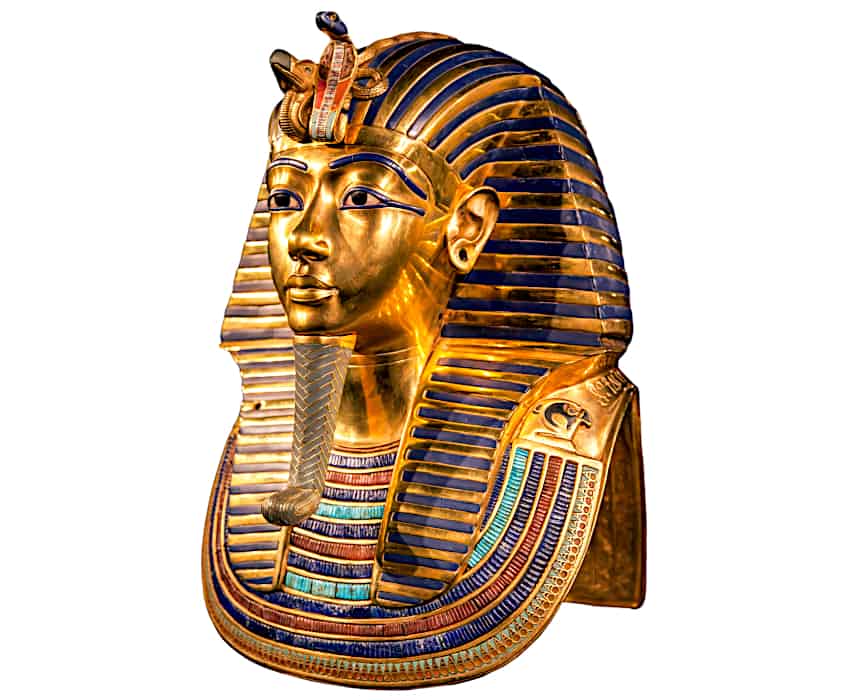
As we are sure you are aware, gold was once a popular option of metal for kingdoms and empires to use as the highest-valued coinage in their currencies. Between its captivating luster and scarce availability, it should come as no surprise that the cultural connotations pertaining to gold reflect ideas of wealth, ostentatiousness, and luxury. In English, we have the phrase “the gold standard”, a term used to describe the definition of a currency’s value in comparison to its territory’s gold supply. Nowadays, we still use the term as an expression meant to define an example of something superior in quality to others of its kind that should be looked at as a reference point.

Gold is also emblematic of victory, winning, and success. This would be the reason why athletes, such as those who perform in the Olympics, are rewarded with gold medals when they achieve first place in competitions. Gold is a pretty powerful symbol of triumph within society, hence why we often bestow it to individuals who have risen to the summit of whichever sport or field.

Our long-standing obsession with gold has managed to retain its grip on our culture to this very day. With all the flattering semiotic connotations attached to gold, we have and maybe always will be obsessed with it. Gold, both the mineral and the color, sees extensive use in fashion and luxury items.
The Color Gold in Religion
Besides its association with wealth and opulence, the color gold also has a unique relationship with world religions that dates back further than antiquity. The second-most popular semiotic values of gold are with respect to the divinity and power of the gods and icons of many religions, of which Christianity would be a good example.
![]()
In Christian art, gold is used extensively as a means to depict the sanctity and faculty of important figures within the theology. Although different symbolic connotations do apply, Hinduism also explores to great lengths the use of gold in its depictions of deities. In Hindu artworks depicting its Gods, you may find many examples of deities being portrayed with golden halos crowning the top of their heads. In Hinduism, the color gold symbolizes wisdom and virtue.
Color Theory of How to Make Gold Paint
If you are already prepared to go through the effort of acquiring all the paints and materials necessary to create different shades of gold, you might as well do some diligent research on the process before starting. This is to ensure that the crisp and lustrous elements that define the common ground between all shades of gold are present. You might also wish to understand how to produce several different shades of gold or adjust their tones. Irrespective of which process pertains most to the task you are trying to achieve, it is important that you have a good degree of knowledge regarding color biases and temperature, and how they affect colors.
Before we get into the thick of how to make the gold color with different combinations of colors, allow us first to talk briefly about an aspect of color theory that is critical to mastering paint mixing.
Color Bias Explained
If you have pre-existing background knowledge of some of the more popularly recognized facets of traditional color theory, you may find the concept of color bias fairly easy to comprehend. For starters, if such is the case then you ought to know that complementary colors can be found on opposite sides of the color wheel and that they produce the highest degree of contrast possibly achievable with either when placed together on the same palette.
You should also know that the colors red, yellow, and blue are called primary colors and that these three colors are the basis for every other color on the spectrum.
But these are the basics. Color bias, however, often rests in the shadows of the preeminence shared between these more commonly known theories. Learning how it works can be a great step toward your mastery of paint mixing. If you can establish a firm grasp on the principles of color bias, you can more easily mix colors to produce others without hassle or error.
Even without ready access to the internet or other informational material, you can draw from your understanding of color biases to mix colors.
An easy yet potentially reductive way to describe color bias is as a color’s relative temperature, how this can be assessed to determine which neighboring color on the wheel it leans towards, and how this influences not only the color of the paint but also how it behaves when mixed with other pigments.
Think about a warm shade of yellow. Why is it considered warm? Well, because a fraction of its pigment composition contains the color red. Thus, a warm yellow should have a color bias toward red. Yellows with a red bias are typically considered to be shades of orange. On the other hand, a cool yellow would lean more so to blue. Cool yellows with a color bias towards blue will appear to have a green tinge.
So, Why Is This Important to Understand?
If you are going to be mixing paint, it is critical that you understand how color biases affect the relationship between the colors you intend on mixing. If you know much about the three primary colors, you should know that the combination of all three in the same ratio produces a muddy brown.
To prevent your paint mixture from becoming a mess of sludgy swamp water, you will want to avoid mixing all three primary colors together.
This is where color bias becomes important to understand. If, for example, you mix a blue with a warm yellow with a color bias towards red then you would unwittingly have combined all three of the primary colors. Likewise, if you try to create a green by mixing a warm yellow and a cool blue then you would once again be left with a gross, muddy color since all three primary colors would be present in the mixture.
The trick to producing clean and warm shades of gold that brim with vibrancy is to choose base colors that have a color bias toward red. To produce cooler metallic golds, you should perform the reverse of the former process by picking base colors that have a bias leaning towards blue.
How to Make Golden Color Shades
As is the case with any other color on the spectrum, the color gold can be separated into a number of different shades. The relative color temperature of whichever hues you decide to use as your base will ultimately help determine the sort of shade produced. Alongside this, your decision on whether or not pink is added to the mix will also affect the outcome of the shades you produce. Below we have tabulated some of the more common and popular shades of gold.
| Gold Shade | Hex Code | RGB Color Code | CMYK (%) | Color |
| Light Golden Rod | #FAFAD2 | 250,250,210 | 0, 0, 16, 2 | |
| Pale Golden Rod | #EEE8AA | 238,232,170 | 93.3, 91, 66.7 | |
| Khaki Gold | #F0E68C | 240,230,140 | 0, 0.041, 0.412, 0.058 | |
| Vegas Gold | #C5B358 | 197,179,88 | 0, 8, 57, 23 | |
| Old Gold | #CFB53B | 207,181,59 | 10, 20, 90, 10 | |
| Metallic Gold | #D4AF37 | 212,175,55 | 0, 0.125, 0.996, 0 | |
| Golden Yellow | #FFDF00 | 255,223,0 | 0, 25, 100, 0 | |
| Gold | #FFD700 | 255,215,0 | 10, 15, 90, 10 | |
| Golden Rod | #DAA520 | 218,165,32 | 0, 24, 85, 15 | |
| Orange Gold | #FFA500 | 255,165,0 | 0, 14.9, 70.2, 15.7 | |
| Dark Orange Gold | #FF8C00 | 255,140,0 | 0, 48, 93, 14 | |
| Chocolate Gold | #D2691E | 210,105,30 | 0, 44, 81, 47 | |
| Sienna Gold | #A0522D | 139,69,19 | 0, 88, 81, 55 | |
| Saddle Brown Gold | #8B4513 | 139,69,19 | 0, 55, 73, 71 | |
| Golden Brown | #996515 | 153,101,21 | 0, 0.339, 0.862, 0.4 | |
| Peru Gold | #CD853F | 205,133,63 | 0, 0.245, 0.699, 0.152 | |
| Pale Gold | #E6BE8A | 230,190,138 | 0,17,40,10 |
How to Make the Color Gold
Mixing paints to produce the color gold is easier than you perhaps assume. The real difficulty, however, lies in nailing the sheen. You can figure out what colors make gold and what combinations thereof produce the shades that correspond to what you are looking for, but a fair bit of creativity may need to be applied when it comes to producing an appropriate mixture to get it to give off that eye-catching burnish we love so much.
Let us not segue too far from the primary topic of this article. If you want to learn how to make the color gold, what two colors make gold, or how to make gold paint, then you are exactly where you need to be. Below we have detailed two of the easiest and most popularly applied methods of how to make the color gold at both a warm temperature and a cool temperature, respectively.
First Method: Using Yellows and Browns
The first and most typical combination of colors used to produce warm gold shades involves the mixing of yellows and browns. It is nifty knowing what two colors make gold if you want to mix it with as few ingredients as possible.
For this task, you are going to need both your yellow and your warm to be of a warm temperature. It is rather easy to find yourself an appropriately bright yellow but, given how neutral brown’s aesthetic values tend to be, you might struggle to pick out a shade of the right temperature. Before buying or mixing the brown you intend on using in this gold mixture, you are encouraged to ensure that it carries a bias towards red. You can refer to the internet on your phone or ask a store clerk for assistance should you not be able to determine by sight.
If you wish to know how to make a golden color that is of a vibrant hue, we would suggest that you consider mixing the following two shades: ochre brown and school bus yellow.
| Shade | Hex Code | RGB Color Code | CMYK Color Code (%) | Color |
| Ochre Brown | #CC7722 | 204, 119, 34 | 0, 42, 83, 20 | |
| School Bus Yellow | #FFD800 | 255, 216, 0 | 0, 15.3, 100, 0 |
This is perhaps the easiest way in which to quickly whip up bright and warm gold shade given how simple the mixing ratio instructions are. All that you need to remember is that the mixture requires equal parts of most colors. If you would like to play around with the tones, you can shift the ratios in either direction. If you want to bump up the brightness, be a little more generous with the yellow and vice versa with the brown if you wish to darken or mute your gold.
Second Method: Using Primary Colors
Remember when we talked about the results produced by mixing all three of the primary colors? Well, sometimes doing so can have its place, such as in the making of the color gold. Although this can be seen as a more convoluted and protracted means of achieving the same result, you can tweak your mix of reds, yellows, and blue until the brown they produce is of a shade you deem suitable for a brown-yellow combination that mixes into a gold. You can then mix the brown in with school bus yellow, leaving you with a stunning gold shade.
We would recommend that you use the following combination of primary color shades:
- Cobalt blue
- Coquelicot red
- School bus yellow
| Shade | Hex Code | RGB Color Code | CMYK (%) | Color |
| Cobalt Blue | #0047AB | 60, 60, 0, 0 | 0, 15.3, 100, 0 | |
| Coquelicot Red | #FF3800 | 100, 22, 0 | 0, 78, 100, 0 | |
| School Bus Yellow | #FFD800 | 255, 216, 0 | 0, 15.3, 100, 0 |
If you mix all these three colors together in an equal ratio, you will be left with a warm and earthy brown not too dissimilar from the ochre brown we discussed in the method prior. Once you have this brown color, you may proceed to mix in an equal amount of school bus yellow to ultimately produce a strikingly beautiful gold color.
How to Make Gold-Color Tones
The two processes we have just discussed pertain to the creation of a very particular shade of gold. If you want a bit more variety than just this, you are going to need an understanding of how to adjust the tones of your gold colors. This is an excellent way to diversify your palette, not just with gold but with any color that you could imagine. Allow us to briefly go over some of the easier means and methods through which one may go about adjusting shades of gold into different tones.
How to Mix Gold Paint Lighter
When it comes to adjusting the brightness of your gold’s tone, you have two choices at your disposal and either one is as easy as the other. Your first option is to add small drops of white into your mix and the second option is to instead add yellow, both of which will lighten the tone of gold.
What is perhaps the most common is to use white as this color can be used almost universally to lighten the tone of any shade.
While it may do the job well, it may be difficult to achieve if you are less experienced. For starters, you may find yourself struggling to lighten the tones of your colors using white without inadvertently muting the colors in the process. If you want to produce a gold with as much vibrancy as possible, you may want to tread carefully when toning with white. Remember that you can always add but not subtract, so make sure to add white in small increments until you reach your desired tonal output. Slow and steady wins the race.
All things considered; we would keenly suggest that you follow the method involving the use of additional yellow to lighten the tone. Unlike white, yellow will not mute your gold. Better yet, given that yellow will already be one of the base colors of your shade of gold, the addition of more yellow will alter the tone without disrupting the vibrancy of its shade. Just as with when you are working with white, however, mix your yellow in using small dashes at a time.
How to Make Gold Paint Darker
Adjusting the tone of your gold color to something a bit darker can be achieved by adjusting the ratio of yellow to brown in the mix so that the former is dominant. We recommend using this method to darken the tones of your gold if you would prefer that its temperature remains the same. This is essentially the reverse of how adding yellow lightens the tone.
If, however, you are interested in tweaking the color temperature of your golden shades then you can try another method instead. This one involves the addition of a deep and warm shade of orange into the mix. At the end of the day, however, these are just our suggestions. What we do seriously encourage is that you go out there, explore and experiment until you find your perfect shade of gold.
What Colors Make Rose Gold?
At this point, we now know not only how to make gold paint but also how to alter it into various shades and tones. If you know anything about the gold color wheel, however, you will of course know that rose gold is by far the trendiest shade in its spectrum. Bright, rich, and playful, this color wins the adoration of it-girls from all across the world.
Since we are on the topic of what colors make gold, we might as well discuss what colors make rose gold. The first clue is in its hue, which boasts obvious hints of pink. You might think that this implies pink is the ideal color to mix with gold to create a rose color, but the correct addition is actually red (you should add only a small splash at a time while mixing).
Compared to your standard shades of gold, rose gold stands in contrast on account of how much brighter it is compared to its kin. To ensure that your rose gold paint mix exhibits the same characteristics quintessential of the shade, you can add a few drops of silver paint and mix it into the gold until you produce something closer to rose gold. Once you have mixed the shade, you can adjust its properties the same way as you would for any other shade of gold. There you have it – an easy explanation for how to make a golden color in the shade of rose gold.
Making Your Gold Shimmer
Being both lustrous and shiny is an absolute prerequisite for the production of the core aesthetic values of the color gold. The instructions we have given you thus far on the topic have not yet covered this essential component of how to make the color gold. Without its iconic sheen and glow, the color gold will end up looking rather flat and boring.
The easiest way to get your gold shades to start looking metallic and reflective is to add luster powder. This decorative material will get your gold looking like the real deal with little to no effort. This product is also widely available from art and craft stores and sold as a staple painting supply in most regions worldwide.
How to Get the Most Out of Your Gold Shades
By now, you should know how to mix gold paint shades that are both aesthetically pleasing and convincing in their portrayal of the color’s most notable features. The last thing you need to learn now, however, is how to properly pair your golds with other colors to highlight the elegance of the prior. Beyond knowing how to mix gold paint, you should also know how gold can be paired with certain complementary or analogous colors to further adjust its contrast, brightness, and richness.
Base Colors
Starting off our list of good things to know regarding how to pair gold, we have the use of base colors. On a canvas or any other painting surface, you can apply a base layer that the gold can rest on top of in a manner that produces a strong contrast. By making the background of your artwork a color like red, the wealth of tone carried by the color gold can be emphasized to stunning effect.
The way to go about this is by painting the surface onto which your gold will be applied with the color red. Once it has dried, you can begin to apply your gold paint above. With red as the base color beneath your gold, you will be impressed by how much of an influence this has on the aesthetic qualities of your finished piece.
Complementary Colors
Complementary colors sit across from one another on the color wheel. When paired, they will produce a contrast stronger than can be achieved with either and any other color on the visible light spectrum. Complementary colors, funnily enough, can also be called “opposite colors”. In this case, opposites really do attract.
Gold as a color is typically very warm, meaning that its complement must be quite cool. If you want to create a dynamic and striking visual effect using gold, you should consider pairing it with a cool blue or purple – depending on the ratios and color combinations used to produce your gold, one of these two colors will be the best option to choose from. If you are unsure as to what works best, the golden rule is that purple complements this color best.
An interesting take away from the aesthetic relationship between complementary colors, which in this case are gold and purple, is that the difference in vibrancy causes the lighter shade to pop out of the canvas. The darker shade recedes, highlighting the lighter shade as it does so. With this in mind, you can imagine all the breathtaking manners in which this tool can be applied in the world of art – or at least the part of it that concerns itself with gold and purple.
The cool thing about this visual effect is that it can make your gold color look as if it is lifted deeper into the foreground, suspended ever so noticeably above the surface.
Analogous Colors
We know that complementary colors are those that sit diametrically from one another on the color wheel and that, when placed together on a palette, will produce the highest contrast possible for either. Analogous colors, on the other hand, are ranges of colors that rest side by side on the color wheel. Analogous colors always work well with one another on account of their similarities in shade, temperature, and tone – hence the name.
Pairing gold on a palette with colors analogous to it is a surefire means to create a striking and vibrant piece. However, one pitfall to try avoiding is pairing too many bright shades together. This could very quickly lead to an untenable vibrancy that overwhelms the eyes. What we would suggest is that you opt to pair your gold with analogous colors that lean more so toward the neutral side of things.
A good note to take heed of is that muted reds can be paired with gold to make the latter appear to have more gleam. Another pro tip to keep in mind is that despite their similarities, golds and yellows typically do not work well together. The issue herein is that they are far too similar to one another. The yellow will dilute the presence of the gold, causing the palette to blend and detract from the more appealing aspects of gold.
Neutral Colors
Pairing your golds with an appropriate neutral shade is another easy way to accentuate the luster of its shade. If you are unsure about what constitutes a neutral color, think about it in terms of temperature. Neutral colors tend to lack a definitive temperature, typically resting somewhere between warm and cold – Goldilocks’ preferred choice, mind you. The colors tend to do well in a supportive role, doing wonders to highlight the primary color of any artwork. The best neutral colors to pair with gold would be either brown or gray.
Their absence of vibrancy helps draw out the abundance thereof in the gold.
Black can also be a great option. However, it may be worth noting that black is technically not a neutral color. The void of blackness, however, also works as a means to highlight the gold and assist in making it pop out of the frame. If you choose to pair gold with black, try to avoid using a duller gold so as to prevent it from blending with the black into a muddy mess.
How to Mix Gold Paint in Neutral Shades
Gold is a color whose attributes determine its shades for the spotlight, meaning the qualities of gold shades will often naturally cause them to be the focal points of a color palette in which they appear, even when such is not the intention.
This being said, there is a trick to using gold as a less imposing addition to a palette in which it is meant only as an accent. The trick in question involves removing some of the shimmer of your gold to make it suitable as a background color. One of the best ways to prevent your gold shades from being too distracting is to mix the paint using neutral bases.
To remove enough of the luster of gold for it to sit unobtrusively in the background, you need to alter the ratios of the bases and potentially add dashes of additional colors. Typically, you will want to increase the volume of brown used in your mixture. Alternatively, if your gold is still too vibrant then you could also add a little bit of gray to the mixture. Follow this process if you would like to produce a neutral gold that can be used to detail larger artworks.
How to Mix Gold Paint for Accenting
As we have discussed prior, gold is a color that you can struggle to prevent from becoming a focal point of any palette. However, you can use this to your advantage by using gold as an accenting color to highlight features of your artwork that you would like the viewer’s attention to be drawn to.
So, gold can still be used as an accompanying color with you having to neutralize its shimmer. You can instead take advantage of the color’s eye-catching attributes to direct the gaze of audiences to key elements of your artwork.
If you plan to use gold in this way, you need to make sure that your gold remains bright and shimmery when mixing it. As a matter of fact, when you use gold as an accenting color, you can actually aim to produce a brighter shade. You can do this by adding either white or yellow, as previously mentioned (remember – yellow is the better choice!). Also, gold luster can be added to the paint to further improve upon the shimmer.
Thank you for your attention. Hopefully, we have dispensed some useful information that you will soon find practical uses for. Explore our blog for more in-depth pieces on all things art-related. Until then, we wish you the best of luck with your future art projects!
Frequently Asked Questions
What Color Is Gold Most Similar To?
The material that gold, the mineral, is most similar to in color is copper. In terms of the color gold, it is technically most similar to the colors yellow and brown. This is not only on account of the similarities of their aesthetic properties but also because gold is produced through the combination of these two colors. So what color is gold most similar to? Depending on the shade, gold can either be more similar to yellow or to brown.
How to Mix Gold Paint?
If you want to create gold paint, mix equal parts yellow with brown – the brighter the pairing, the better. You can also add additional materials, such as gold luster, to increase the shimmer of your paint.
What Colors Make Rose Gold?
You can create rose gold by mixing gold (made with yellow and brown, plus any additional materials to add luster) with a red. Be sure to only add a small amount of red at a time so as to avoid overdoing it and ruining your gold paint. We can assure you, it is much easier to add than subtract.
Megan is a writer and researcher who holds a degree in Social Sciences, with a specialization in Psychology and Environmental Science, from the University of Cape Town. Her dedication to acquiring knowledge and making a positive impact has driven her current work in promoting conscious and sustainable growth in Southern Africa. Megan’s interests encompass exploring the physical and psychological impacts of color in our environment on our mood and well-being. She is also passionate about the role of art and creativity, which has been an integral part of society since the beginning of human history. Since 2022, Megan has been contributing blog posts on painting and color theory at artfilemagazine.
Learn more about Megan van Schoor and about us.
Cite this Article
Megan, van Schoor, “What Colors Make Gold? – How to Mix and Use Shades of Gold.” artfilemagazine – Your Online Art Source. January 27, 2023. URL: https://artfilemagazine.com/what-colors-make-gold/
van Schoor, M. (2023, 27 January). What Colors Make Gold? – How to Mix and Use Shades of Gold. artfilemagazine – Your Online Art Source. https://artfilemagazine.com/what-colors-make-gold/
van Schoor, Megan. “What Colors Make Gold? – How to Mix and Use Shades of Gold.” artfilemagazine – Your Online Art Source, January 27, 2023. https://artfilemagazine.com/what-colors-make-gold/.



